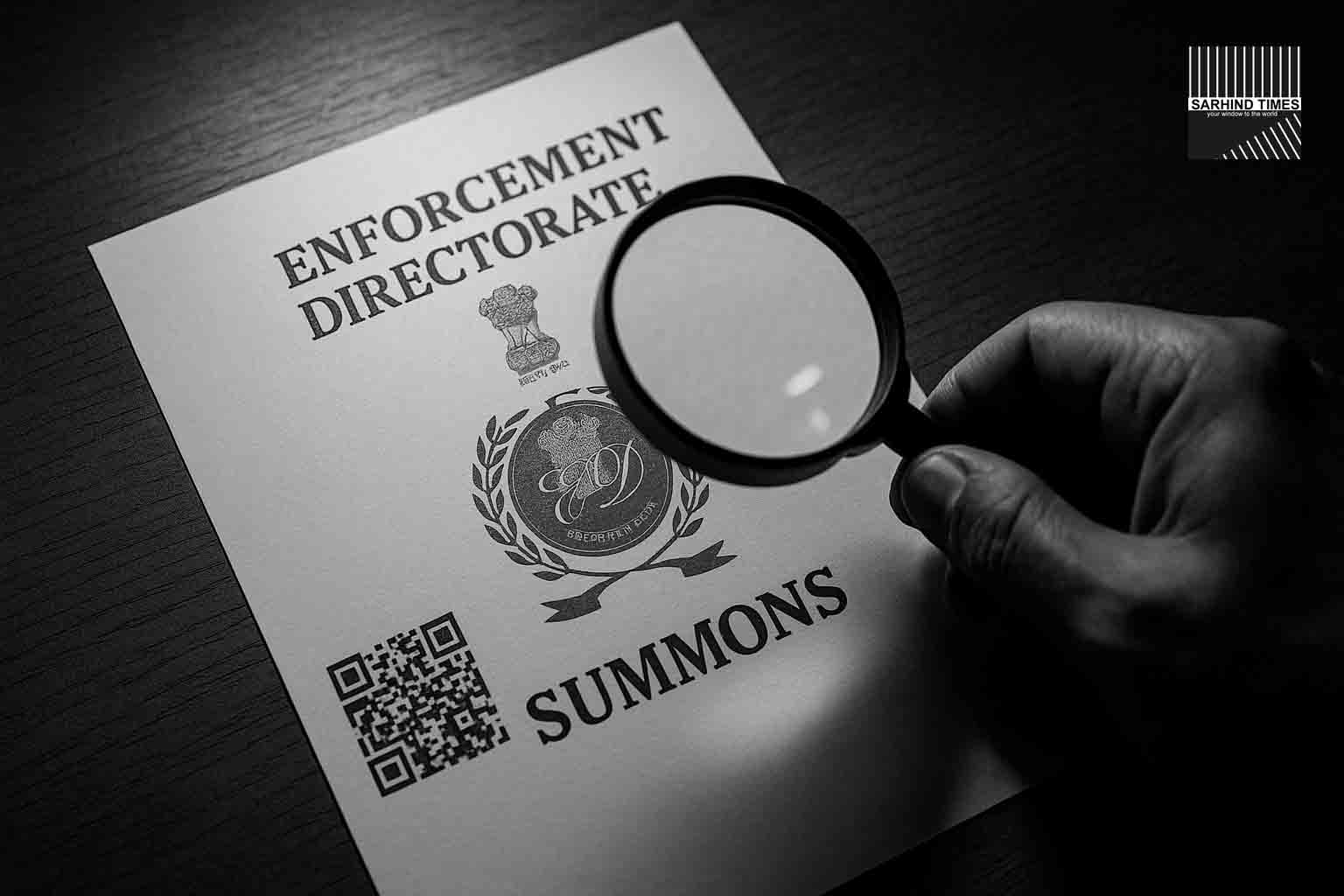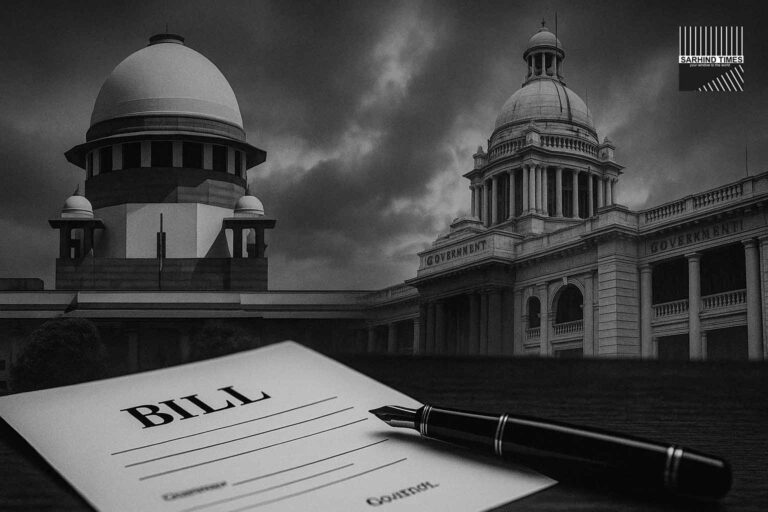The Enforcement Directorate adopts QR-based verification and unique passcodes for summons, aiming to counter fraud, impersonation, and extortion linked to forged documents.
By SarhindTimes Bureau
New Delhi, October 2025
A Digital Move to Restore Trust
In a first-of-its-kind step toward secure digital governance in law enforcement, the Enforcement Directorate (ED) has introduced a new summons verification system featuring QR codes and unique passcodes.
The initiative, rolled out this week, is designed to tackle a rising wave of forged notices—documents that mimic ED summons to intimidate individuals and businesses or extort money under false pretenses.
By embedding QR codes directly into official summons, the ED seeks to empower recipients to authenticate notices instantly, cutting off avenues for fraudsters who exploit fear and ignorance to deceive citizens.
“Every legitimate ED summons will now carry a traceable QR code linked to our official database,”
said a senior ED official on condition of anonymity.
“Recipients can scan it using any mobile device and verify authenticity on the agency’s official portal. This is not just a tech upgrade—it’s a trust upgrade.”
The Problem: Fake Summons and Extortion Rackets
For years, the ED’s growing public profile—particularly amid high-profile money laundering cases—has also made it a target for impersonation rackets.
Several incidents have been reported where individuals received counterfeit notices demanding “settlement amounts” or personal meetings under threat of arrest. These forged documents often carried replicated seals, letterheads, and fake signatures.
In many cases, the victims—especially small entrepreneurs and politically exposed individuals—paid bribes or sought “fixers” to avoid supposed legal trouble.
“The system had become ripe for exploitation,”
said Adv. Pooja Sinha, a Delhi-based criminal lawyer.
“With high-profile cases dominating headlines, the public associates ED summons with fear. That’s what fraudsters exploit.”
How the QR-Verification System Works
The new mechanism is elegantly simple yet technically robust.
Each summons issued by the Enforcement Directorate will now include:
- A Unique QR Code – which links directly to the ED’s secure verification portal.
- A Six-Digit Passcode – printed on the document and required to access the verification result.
- Secure Template ID – every template is logged in a centralized audit trail.
Upon scanning the QR code, the recipient is redirected to a government domain (ending with “.gov.in”) where they can input the passcode and verify the authenticity of the summons.
The portal will display:
- Name of the issuing officer
- Case reference number
- Date and time of issuance
- Designation and zonal office
If the summons is not genuine, the system will display a red alert message: “This notice is not issued by the Enforcement Directorate. Report immediately to your nearest zonal office or police station.”
An Antidote to Digital Forgery
Digital forgery has become one of the fastest-growing vectors for financial and legal scams. With the proliferation of editing tools and AI-generated documents, even trained professionals sometimes struggle to distinguish authentic government letters from counterfeits.
The ED’s move acknowledges this reality. Officials admit that the barrier to creating fake documents has collapsed in the digital era.
“Scammers no longer need printing presses; a high-resolution PDF and a cloned signature can do the damage,”
noted Dr. Sandeep Goel, cybersecurity expert and former CERT-In advisor.
“Embedding verifiable digital footprints is the only way forward.”
By introducing machine-verifiable summons, the ED joins a growing number of government bodies integrating blockchain-inspired verification layers into public documents.
Legal and Ethical Ramifications
The initiative also holds legal significance under the Indian Evidence Act and the Information Technology Act, 2000.
Authenticated QR-linked documents can serve as digitally admissible proof, establishing the chain of custody and reducing procedural ambiguity.
“A QR-backed summons leaves no room for dispute over authenticity,”
explained Adv. K. V. Singh, legal consultant for corporate compliance.
“It ensures due process while protecting citizens from harassment.”
Civil liberties groups, while welcoming the move, have urged the government to supplement it with a 24×7 public helpline and transparency reports detailing the number of summons issued and the cases they relate to (minus confidential details).
“Verification is good, but accessibility is better,”
said Anjali George of the People’s Rights Collective.
“Ordinary citizens must have quick redressal channels if they suspect a fake notice or an overreach.”
A Pattern of Modernization in Enforcement
The QR-code rollout is part of a broader pattern of digital modernization across India’s enforcement agencies.
Over the past two years, the Central Bureau of Investigation (CBI), Income Tax Department, and Serious Fraud Investigation Office (SFIO) have all begun experimenting with e-summons, encrypted communications, and blockchain-based evidence trails.
The ED’s initiative, however, stands out for its public-facing verification model—a rare example of citizen-oriented enforcement design.
“For decades, enforcement was about opacity. Now it’s about transparency,”
said a senior official in the Finance Ministry.
“Technology allows agencies to preserve confidentiality while proving authenticity.”
Training and Implementation
Internally, the ED has issued circulars mandating training sessions for staff across zonal offices.
Field officers will learn how to generate, encrypt, and dispatch the new digital summons formats.
Each issuance will be tracked via an automated audit trail maintained at headquarters, ensuring accountability in the chain of communication.
A dedicated internal verification team will handle public queries and cross-check requests, particularly during high-volume investigative phases.
Officials confirmed that the new format will be mandatory for all new cases starting November 1, 2025.
Compliance Sector Reacts Positively
Businesses and compliance professionals have welcomed the move, calling it a relief from procedural ambiguity.
“This reform closes a major gray area,”
said Rohit Jain, Chief Compliance Officer at a multinational conglomerate.
“Companies often struggled to verify whether a summons was real, leading to unnecessary panic or delay. The new system gives clarity and confidence.”
For legal teams handling large corporate audits, instant authentication reduces response errors and ensures timely cooperation with authorities—critical for maintaining regulatory goodwill.
Cybercrime Experts: “A Model for Other Departments”
Cybercrime specialists have praised the ED’s digital initiative as a model that other enforcement and tax bodies should replicate.
“The digital QR system is a practical, low-cost barrier against a high-cost problem,”
said Rajat Malhotra, head of the Cyber Secure Foundation.
“It combines technology and deterrence — making impersonation risky and traceable.”
According to industry data, India reported over 25,000 cases of impersonation-related frauds in 2024, many involving forged documents, government IDs, or fake notices.
The ED’s approach could therefore become a national template for document authenticity in other areas such as:
- Income tax scrutiny notices
- Customs and GST summons
- Financial regulatory communications (SEBI, RBI, MCA)
Balancing Enforcement with Civil Rights
The new QR system also arrives amid ongoing public debate on the scope and powers of investigative agencies.
While agencies argue for stronger tools to fight money laundering and economic crime, citizens have demanded greater transparency and safeguards against misuse.
The digital verification move may help bridge that trust gap, signaling a willingness to adapt and self-audit.
“This is how institutions mature—by combining power with accountability,”
said Justice (Retd.) P. V. Ramesh, former High Court judge.
“Digital authentication is both a shield and a mirror: it protects citizens and reflects the agency’s own credibility.”
Parallel Enforcement Push
Even as the verification system launches, the ED continues to pursue a busy enforcement calendar.
This week alone, the agency conducted searches in Delhi, Hyderabad, Mumbai, and Kochi, tied to cases under the Prevention of Money Laundering Act (PMLA).
Officials clarified that the modernization drive is not meant to soften the agency’s posture but to make its operations more defensible and transparent.
“Technology makes it harder to question our processes,” said a senior investigator.
“When every summons, record, and reply is digitally logged, accountability is built in.”
Call for a Central Verification Portal
Several legal experts suggest that the ED’s system could evolve into a unified government verification hub where citizens can authenticate documents from multiple departments through a single portal.
Such an integrated platform—similar to DigiLocker for personal records—could drastically reduce document fraud and administrative friction across India’s legal landscape.
“Imagine a one-stop window for all official communications — from the ED to the Income Tax Department,”
said Rohini Datar, governance consultant.
“That’s where India’s digital governance is heading, and this step is an early milestone.”
Editorial Analysis: A Rare Moment of Process Innovation
In India’s enforcement ecosystem—often criticized for opacity—the ED’s QR-coded summons stand out as a progressive step toward procedural integrity.
For decades, citizens have associated summons with anxiety, secrecy, and fear. By offering verifiable transparency, the agency is turning technology into a trust-building instrument.
Yes, it’s still enforcement. But it’s enforcement with accountability.
And in an era when misinformation spreads faster than justice, that difference matters.
The Road Ahead
The next few months will test the system’s robustness.
Will citizens adopt the verification habit?
Will fraudsters evolve new tactics, like spoofing QR codes or cloning URLs?
Officials say constant adaptation will be key. Regular audits, AI-based pattern detection for fraudulent patterns, and integration with cybersecurity agencies are on the roadmap.
For now, however, the move is being hailed as a rare administrative reform that directly benefits the public.
“It’s not often that a law enforcement story is also a digital governance story,”
quipped a senior journalist at the event.
“But this one is — and that’s the right kind of disruption.”
Conclusion: From Fear to Verification
By embracing digital transparency, the Enforcement Directorate has taken a step that transcends bureaucracy. It’s a recognition that credibility is the foundation of enforcement.
When citizens can check, verify, and trust — the law becomes not just a force but a framework for fairness.
As India modernizes its governance playbook, QR-coded summons may be remembered as a small reform with a big signal:
that in the age of cybercrime, authenticity is the new accountability.
#ED #Governance #Cybercrime #FraudPrevention #RuleOfLaw #Compliance #DigitalIndia #Transparency #PublicTrust

























+ There are no comments
Add yours